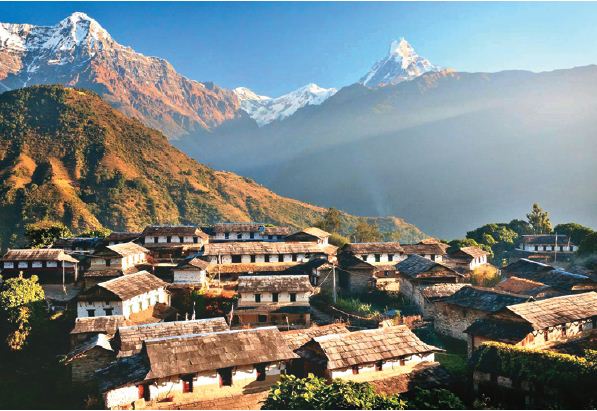Roughing it out - Poon Hill
Ghorepani: Dawn's golden warmth caught the tops of snowcapped Himalayas and gradually crept downward as the rising sun lit up a sweeping arc of soaring peaks, at once forbidding and starkly beautiful.
The stunning vista from the top of Poon Hill — at 3,193 m (10,475 ft), the highest point of our family's six-day trek in Nepal — was among many highlights of a 'Lord of the Rings'-like adventure through lush forests, terraced fields and traditional villages nestled above plunging valleys.
Sometimes the going was tough — like hiking two hours up steep, stone steps. Other times, we walked along gently undulating woodland paths.
Along the way, there were rewards: children who ran to greet us (sometimes asking for money or candy), wildflowers beside the path, breathtaking views and cups of hot masala tea at cute little rest stops. If you're looking for a family adventure that immerses you in nature, beauty and a fascinating culture — and you're willing to rough it some — consider trekking in Nepal.
Our two boys, 12 and 10, loved the experience. One of my older son's favourite parts was the camaraderie with other trekkers from around the world in common rooms at the 'tea houses', or simple lodges where we stayed.
Children as young as eight or nine could handle the popular 65 km Ghandruk-Ghorepani-Poon Hill loop we hiked located just south of the Annapurna Range. Small children can be carried on the backs of porters.
We hiked four to six hours daily, depending on the trail's difficulty, usually reaching our destination by 3 pm, allowing time to relax before supper.
With good weather, this route will give you stunning views of a string of mountains, including Annapurna I (8,091 m), tenth-tallest in the world; Machhapuchhre, or 'Fishtail,' with its distinctively shaped peak; and the towering Dhaulagiri (8,172 m), the world's seventh-tallest. Mount Everest, located 300 km to east, isn't visible on this loop.
The circuit starts and ends near the lakeside town of Pokhara, Nepal's trekking hub. Peak trekking season in October and November, when skies are clearest and temperatures hover between 15-25 degree Celsius. We mostly hiked in T-shirts and shorts (women's shorts should be knee-length out of respect for the local culture). But early mornings and evenings, when it got as cold as 5 degree Celsius, we needed fleeces and long pants.
April and May, also a good time to go, can be cloudier, but the rhododendron trees are in bloom. June, July and August are rainy.
Be prepared to rough it. Some teahouses offer hot showers but water supplies are often limited. Rooms are Spartan
but clean. Blankets are available, but most trekkers bring sleeping bags, which can be rented or bought in Pokhara or Kathmandu at shops that sell everything you need, including knock-off brand fleeces and backpacks. Trekking poles, about USD five apiece, are recommended, especially when descending. Don't buy hiking shoes when you arrive; break those in at home.
The food is rather monotonous: lots of dal bhat, or lentil stew with rice, plus curries, pastas and soups, and not much meat or fruit. Deep-fried 'Gurung bread' is quite good. You may want to bring canned tuna or meat.
As for that sun rise from Poon Hill: We woke at 5 am and hiked 45 minutes from the village of Ghorepani to see it, and we shared the experience with 300 to 400 other trekkers. Like the rest of the trip, the effort was well worth it. We got a panoramic view of both the Annapurna and Dhaulagiri ranges in all their majesty. — AP





